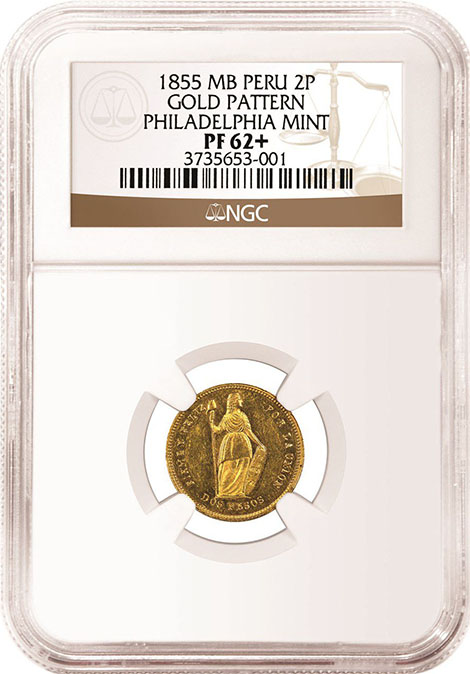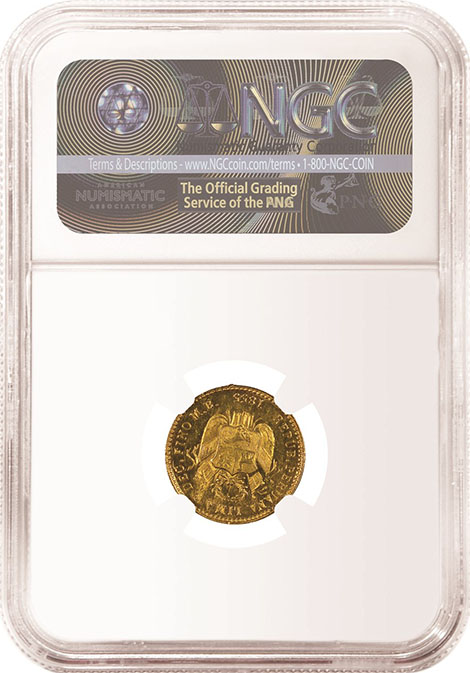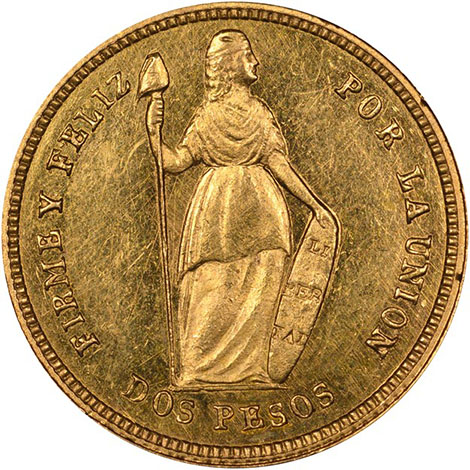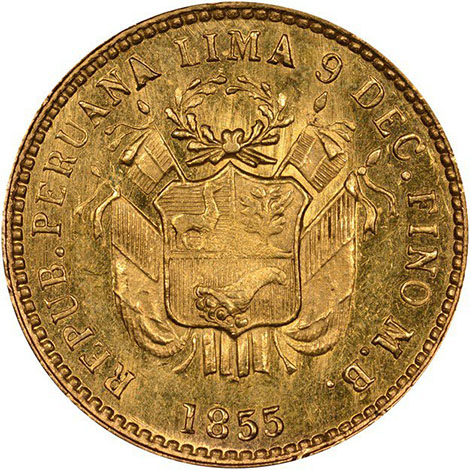Numismatic Guaranty Corporation (NGC) has graded an 1855 Peruvian Pattern 2 Peso in gold that was the first pattern struck by the United States Mint for a foreign country. “Patterns” are sample coins that were struck to test a new design, composition, denomination or other new feature. They were typically struck in extremely small numbers for test and display purposes.
The Peru 1855 Pattern 2 Peso came about during a turbulent time in that country’s early history. After it gained its independence from Spain in 1824, Peru became part of a short-lived confederation comprised of three states: North Peru, South Peru, and Bolivia. This ended with the War of Confederation in 1839, which resulted in the separate countries of a unified Peru and Bolivia.
After two wars and many internal political issues, Peru faced several serious economic problems. During these wars, many merchants and businessmen had fled the newly founded country, taking with them their wealth. Money shortages developed as a result—any coins that remained in the country were hoarded and a lack of production at silver mines within Peru prevented new coins from being struck.
The shortage of coins resulted in the use of Bolivian coinage, which had lower silver content than the Spanish coinage upon which Peru’s economic system had been developed, causing confusion and price instability.
Peru subsequently opened more mints within its borders – at Cusco, Cerro de Pasco, and Arequipa – to create solid Peruvian money based off of the old Spanish weights and purities. A decision was made, however, to transition the coinage system from the Spanish octal (e.g. 8 Reales) system to the decimal system. The United States made pattern coinage samples for Peru, hoping to receive a contract for the production of Peruvian coinage. The Peru 1855 2 Peso struck in gold was minted at the Philadelphia Mint, three years prior to the anticipated transition to the decimal system in 1858. Other decimal coinage was struck at Philadelphia in the hopes of obtaining the coinage contract.
Peru, however, opted to continue to produce its own coinage and even modernized the Lima Mint with new steam minting machines from England to replace the aging Spanish colonial equipment. It would be 1863 when Peru finally transitioned to a new system, with the Sol as the replacement for the Spanish peso. A peso was initially valued at 0.8 soles.
The Peru 1855 Gold Pattern 2 Peso is important in the numismatic histories of both the United States and Peru. While the United States had previously produced issues that circulated overseas, this was the first pattern coinage struck at the Philadelphia Mint for a foreign country. This was done before Congress revoked the legal tender status of the Spanish 8 Reales in the Coinage Act of 1857, and it would not be until 1874 when Congress explicitly authorized the United States Mint to contract to manufacture coins for foreign governments (provided that these contracts did not interfere with the required coinage of the United States). For Peru, it marked a transition in their economic history which took years to complete. Ultimately, the foresight that economic reform was needed for financial stability proved to be correct.
The Philadelphia Mint is believed to have struck only six examples of the Peru 1855 Gold Pattern 2 Peso. Of these, NGC has certified two, this example being graded NGC PF 62. The other, formerly from the collection of King Farouk, was graded NGC PF 63. A third example is in the National Numismatic Collection of the Smithsonian Museum and the other three examples are not publicly known today.





